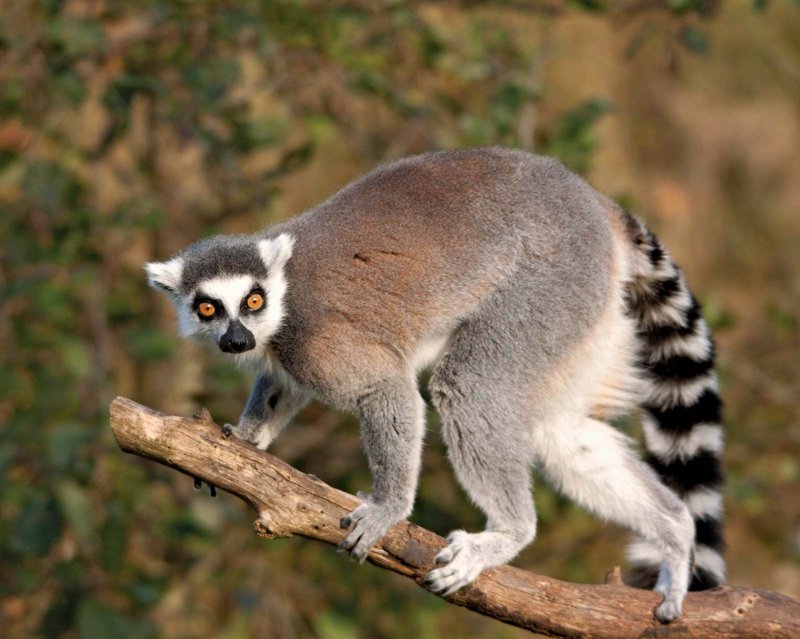
Lemurs are fascinating primates native to the island of Madagascar and the nearby Comoros Islands. If you’re picturing a charming creature with large eyes and a bushy tail, you’re spot on! These animals are part of a larger group called prosimians, which also includes lorises and tarsiers. Lemurs are unique to Madagascar, making them a great example of how evolution can shape species based on their isolated environments.
What sets lemurs apart from other primates? Well, they have some pretty quirky traits! For one, they are nocturnal, meaning many species are most active at night. Their big, round eyes help them see well in low light, allowing them to navigate the dense forests of their habitat. Plus, their social structures are fascinating, often living in matriarchal groups where females lead the pack. It’s a whole different world in lemur society!
Types of Lemurs
There are about 100 different species of lemurs, and they vary dramatically in size, color, and behavior. The most well-known among them is the ring-tailed lemur, famous for its striking black and white striped tail. Other types include the tiny mouse lemur, which is one of the smallest primates in the world, weighing about as much as a common mouse. Then there’s the indri, the largest living lemur, which can grow up to three feet long!
Each species has its own unique adaptations that help them survive in Madagascar’s varied environments. For example, the sifaka, known for its spectacular leaping ability, has powerful legs that allow it to jump between trees with impressive grace. On the other hand, the aye-aye has a long, bony finger which it uses like a tool to extract insects from tree bark. Isn’t nature just ingenious?
Habitat and Distribution
Lemurs thrive in Madagascar’s lush rainforests, but they can also be found in dry deciduous forests and scrubland. Their habitats are rich in biodiversity, providing ample food sources such as fruits, leaves, and flowers. The varied landscape is crucial for their survival, as different species have adapted to specific environments within this island nation.
However, lemurs face severe threats due to habitat loss caused by deforestation, agriculture, and human encroachment. Madagascar’s unique ecosystems are disappearing at an alarming rate, impacting these adorable creatures. Conservation efforts are underway to protect lemurs and their habitats, but the fight is ongoing. It’s a real nail-biter for these fascinating animals!
Diet and Feeding Habits
When it comes to food, lemurs are primarily herbivorous. They munch on a variety of fruits, leaves, flowers, and even some bark. The ring-tailed lemur, for instance, loves to snack on figs, while the indri prefers younger leaves and fruit. Their specialized diets are important for their health and play a role in the ecosystem, as they help in seed dispersal.
Interestingly, some lemurs may also eat insects or small animals, particularly when food sources are scarce. This flexibility in diet allows them to adapt to changing environmental conditions. And yes, lemurs are known for their rather social feeding habits, often foraging together in family groups. Imagine sharing lunch with a group of friends—that’s how these little guys roll!
Behavior and Social Structure
Lemurs are incredibly social creatures, often living in troops that include multiple females and their young. Male lemurs typically leave their natal group when they reach maturity, while females usually stay and maintain close ties with their family. This matriarchal society is somewhat rare among primates and adds a fascinating layer to their social dynamics.
Communication among lemurs is complex, using vocalizations, scents, and even physical gestures. They can express excitement, alert others to danger, or signal their availability to mate through a range of calls. Their vocalizations can be as varied as a simple ‘whoop’ or a high-pitched ‘scream,’ adding to the lively symphony of the Madagascar forest.
Reproduction and Lifespan
Lemurs typically breed once a year, with a gestation period that lasts about four to five months. Mothers usually give birth to a single infant, although twins can occur in some species. Lemur infants are born helpless, relying on their mothers for warmth, food, and protection during their early weeks of life. As they grow, they begin to explore their surroundings and learn essential social skills by interacting with their troop members.
Conservation Status
The conservation status of lemurs is quite alarming. Most species are currently endangered or critically endangered, primarily due to habitat destruction and poaching. Madagascar’s forests are disappearing at a rapid pace, threatening the natural homes of these unique primates. Conservation groups are working hard to protect their habitats and implement sustainable practices that benefit both locals and wildlife.
Education and awareness are key in the fight to save lemurs. By understanding their plight, we can all contribute to conservation efforts, whether through supporting organizations, spreading the word, or even visiting Madagascar responsibly. Every small action counts when it comes to preserving these incredible creatures for future generations.
| Species | Habitat | Diet | Lifespan | Conservation Status |
| Ring-tailed Lemur | Dry deciduous forests | Fruits, leaves | 15-20 years | Endangered |
| Indri | Tropical rainforests | Leaves, fruits | 15-20 years | Critically Endangered |
| Mouse Lemur | Various habitats | Fruits, insects | 8-12 years | Endangered |
| Sifaka | Rainforests, dry forests | Leaves, fruits | 15-20 years | Endangered |
Fun Facts About Lemurs
Lemurs are packed with quirks! Did you know that lemurs have a special scent gland located on their wrists? They use it to mark their territory and communicate with others. This behavior is somewhat like leaving a calling card for other lemurs to sniff. Fun, right?
Another fascinating fact is that lemurs can leap up to 30 feet from tree to tree! Their powerful legs and flexible joints make this possible, allowing them to navigate their forest homes effectively. Think about how it feels to jump over a wide stream—now imagine doing that across treetops!
Lastly, lemurs have a unique social structure where the adults frequently groom each other. This not only helps keep their fur clean but also strengthens bonds within the group. It’s kind of like a spa day with friends, building trust and camaraderie. How awesome is that?
FAQ
Are lemurs dangerous to humans?
Lemurs are generally not dangerous to humans. They are curious and social animals, often displaying playful behavior. However, like any wild animal, they can bite if they feel threatened. It’s best to admire them from a distance and support their conservation.
What do lemurs sound like?
Lemurs have a variety of vocalizations that can range from soothing coos to loud screams. Sounds are crucial for communication, especially in dense forests. So, if you ever hear a lemur calling, know that it’s likely chatting about its day!
Can lemurs be pets?
While lemurs may seem adorable and fun, they do not make good pets. They are wild animals with complex social needs and require specific habitats. Keeping them as pets is often illegal and unethical. It’s better to support their conservation in the wild.
How are lemurs important to the ecosystem?
Lemurs play a vital role in their ecosystems as seed dispersers. By eating fruits and then excreting the seeds, they help promote plant growth and diversity. This contributes to the health of Madagascar’s forests, supporting many other species.
What does a lemur’s diet consist of?
Lemurs primarily eat fruits, leaves, and flowers. Their diet varies by species and available food sources. Some may also include insects or small animals, especially in times of food scarcity. They are important for maintaining their environment’s balance.
How long do lemurs typically live?
In the wild, lemurs usually live between 15 to 20 years, depending on the species. However, in captivity, with proper care, they can live much longer, sometimes over 30 years. Their lifespan is influenced by factors like diet, habitat, and social structure.
What threats do lemurs face?
The biggest threats to lemurs include habitat loss due to deforestation, hunting, and human encroachment. Madagascar’s unique ecosystems are under siege, making it essential for conservation efforts to protect these amazing animals and their homes.
Can lemurs see in the dark?
Yes, many lemur species are nocturnal, meaning they are active at night. Their large eyes are adapted to low-light conditions, allowing them to navigate their environment in the dark. This trait makes them fascinating and skilled nighttime foragers!
Are lemurs closely related to monkeys?
Lemurs are part of the primate family but are more closely related to tarsiers and lorises than to monkeys. They diverged from the common ancestor of all primates millions of years ago, leading to their unique adaptations found exclusively in Madagascar.
Can lemurs be found outside Madagascar?
While lemurs are primarily native to Madagascar, some species can be found in zoos and wildlife reserves around the world due to conservation programs. These initiatives focus on education and research to help protect lemur populations in their natural habitats.
What are lemurs’ mating habits like?
Lemurs typically breed once a year during the mating season. Male competition for females can be fierce, and social hierarchies play a role in which males get the chance to mate. Once mates are chosen, the female usually gives birth to a single infant, strengthening social bonds within the group.

